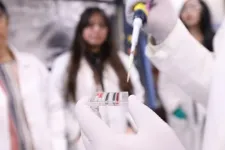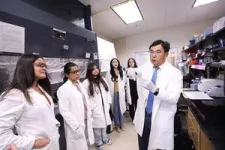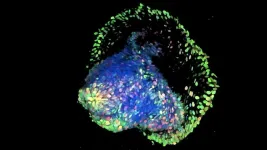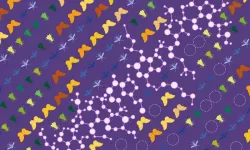(Press-News.org) EL PASO, Texas (Oct. 24, 2024) – Researchers at The University of Texas at El Paso have created a portable device that can detect colorectal and prostate cancer more cheaply and quickly than prevailing methods. The team believes the device may be especially helpful in developing countries, which experience higher cancer mortality rates due in part to barriers to medical diagnosis.
“Our new biochip device is low-cost — just a few dollars — and sensitive, which will make accurate disease diagnosis accessible to anyone, whether rich or poor,” said XiuJun (James) Li, Ph.D., a UTEP professor of chemistry and biochemistry. “It is portable, rapid and eliminates the need for specialized instruments.”
Li is the lead author on a new study describing the device; it’s published in Lab on a Chip, a journal that focuses on micro-scale and nanoscale devices.
Li explained that the most commonly used commercial method of cancer biomarker detection, known as ELISA, requires costly instrumentation to work correctly and can take twelve hours or longer to process a sample. This delay is heightened in rural areas in the U.S. or developing countries, he said, because patient samples must be transported to larger cities with specialized instruments, contributing to a higher rate of cancer mortality.
“If you can detect biomarkers early on, before the cancer spreads, you increase a patients’ chance of survival,” Li said. “Any delays in testing, especially in regions that don’t have access to expensive tools and instruments, can be very bad for a patient’s prognosis.”
The device that Li’s team created is microfluidic, which means that it can perform multiple functions using very small amounts of fluids. The device uses an innovative ‘paper-in-polymer-pond’ structure in which patient blood samples are introduced into tiny wells and onto a special kind of paper. The paper captures cancer protein biomarkers within the blood samples in just a few minutes. The paper subsequently changes color, and the intensity of the color indicates what type of cancer is detected and how far it has progressed.
So far, the research has focused on prostate and colorectal cancers, but Li said the method they devised could be applicable to a wide variety of cancer types.
Li said that the device can analyze a sample in an hour — compared to 16 hours using some traditional methods. According to study results, the device is also about 10 times more sensitive than traditional methods even without using specialized instruments. That means the device can detect cancer biomarkers that are present in smaller quantities, typical of cancer in its early stages. A less sensitive device may not pick up on the smaller quantities, Li said.
Before the device is available to the public, Li said the prototype of the device will need to be finalized and the device tested on patients in a clinical trial, which could take several years. It would require final approval by the Food and Drug Administration before it could be used by physicians.
“Dr. XiuJun Li's innovation significantly improves point-of-care diagnostics by reducing detection times and the need for costly instruments,” said Robert Kirken, dean of the College of Science. “This makes it ideal for resource-limited settings, which will improve early diagnosis and lead to better cancer outcomes. I look forward to seeing what this innovation leads to.”
An additional co-author on the study is Sanjay Timilsina, Ph.D., a former graduate research assistant at UTEP. Li is a member of the Lab on a Chip advisory board.
About The University of Texas at El Paso
The University of Texas at El Paso is America’s leading Hispanic-serving university. Located at the westernmost tip of Texas, where three states and two countries converge along the Rio Grande, 84% of our 25,000 students are Hispanic, and more than half are the first in their families to go to college. UTEP offers 170 bachelor’s, master’s and doctoral degree programs at the only open-access, top-tier research university in America.
END
UTEP researchers develop low-cost device that detects cancer in an hour
Particularly beneficial for rural U.S. areas, developing countries
2024-10-24
ELSE PRESS RELEASES FROM THIS DATE:
Texas A&M physicist Kevin Kelly earns American Physical Society Early Career Award
2024-10-24
Dr. Kevin J. Kelly, an assistant professor in the Department of Physics and Astronomy at Texas A&M University and a member of the George P. and Cynthia Woods Mitchell Institute for Fundamental Physics and Astronomy, has been selected as the 2025 recipient of the American Physical Society’s Henry Primakoff Award for Early-Career Particle Physics in recognition of his contributions and promising career potential in fundamental particle physics and cosmology.
Kelly, who joined the Texas A&M faculty in 2022, works at the interface of two of the biggest outstanding mysteries in particle physics: ...
University of Maryland researcher awarded $1.8 million to study climate change’s impact on people with kidney disease
2024-10-24
Climate change is driving more extreme heat and more air pollution from wildfires, each of which put human health at risk. Now, new research funded by the federal Agency for Healthcare Research and Quality (AHRQ) and led by University of Maryland School of Public Health Professor Dr. Amir Sapkota, will study how these hazards independently and jointly impact already vulnerable groups, such as people living with end stage kidney disease (ESKD). The researchers aim to identify preventative solutions.
“During extreme heat, the damaged kidneys of people with ESKD do not regulate fluid levels very ...
Johns Hopkins Children’s Center research in mice suggests zinc supplements have potential value to directly treat short bowel syndrome
2024-10-24
Researchers from Johns Hopkins Children’s Center say they have identified a gene pathway involving the mineral zinc in mice that may someday point the way to using zinc-based supplements to directly help people with a rare disorder called short bowel syndrome (SBS).
The findings, published Oct. 7 in Nature Communications, help advance efforts toward more effective, potential treatment regimens for both children and adults with the debilitating condition.
SBS, which affects 10,000–20,000 adults and children in the United States, is marked by damage to and shortening of ...
Kalinin receives David Adler Lectureship Award
2024-10-24
Sergei Kalinin, a professor in the Department of Materials Science and Engineering, has been named the winner of the David Adler Lectureship Award in the Field of Materials Physics by the American Physical Society. The award recognizes one outstanding contributor in the field of materials physics who is notable for high-quality research, review articles, and lecturing.
“I am deeply honored to receive the Adler Award, as it recognizes the critical transition in materials discovery that my colleagues at the University of Tennessee and Pacific Northwest National Laboratory and I have championed,” ...
Evaluating the link between chemicals and declining insect populations
2024-10-24
Few people are fans of stink bugs, mosquitoes, or boll weevils, but insects play a key role in the circle of life that makes up the planet’s environment. In fact, world-renowned biologist E. O. Wilson famously declared that if insects vanished, our environment would collapse.
Scientists have noted that insect behaviour has been changing, and their populations are declining – on average 2-3% per year. This has prompted them to investigate the potential causes of this change, such as habitat loss due to overdevelopment, climate change, and chemical use.
EMBL researchers and collaborators recently investigated how pesticides, herbicides, ...
Scientists discover molecules that store much of the carbon in space
2024-10-24
A team led by researchers at MIT has discovered that a distant interstellar cloud contains an abundance of pyrene, a type of large, carbon-containing molecule known as a polycyclic aromatic hydrocarbon (PAH).
The discovery of pyrene in this far-off cloud, which is similar to the collection of dust and gas that eventually became our own solar system, suggests that pyrene may have been the source of much of the carbon in our solar system. That hypothesis is also supported by a recent finding that samples returned from the near-Earth asteroid Ryugu contain large quantities of pyrene.
“One of the big questions in ...
Sublethal agrochemical exposure disrupts insect behavior and long-term survivability
2024-10-24
Even at concentrations too low to kill, exposure to widely used agrochemicals – pesticides, herbicides, and fungicides, among others – has pervasive negative impacts on insect behavior and physiology, researchers report. The findings highlight the need for more comprehensive pesticide assessments, focusing not just on lethality but also on unintended long-term ecological harm to safeguard biodiversity. Over the past decade, many reports have highlighted alarming declines in insect ...
Understanding that US wildfires are becoming faster-moving is key to preparedness
2024-10-24
“The modern era of megafires is often defined based on wildfire size,” say Jennifer Balch and colleagues in a new study, “but it should be defined based on how fast fires grow and their consequent societal impacts.” Balch and colleagues report that wildfire growth rates in the U.S. have surged over 250% over the last 2 decades. Although these fast-moving infernos, or “fast fires” – those spreading more than 1,620 hectares in a day – account for only 2.7% of wildfire events from 2001 to 2020, researchers report that they are responsible for 89% of the total structures damaged ...
Model predicts PFAS occurrence in groundwater in the US
2024-10-24
According to a new machine learning-assisted predictive model, as many as 95 million Americans may rely on groundwater containing PFAS for their drinking water supplies before any treatment, researchers report. This raises concerns about unmonitored contamination in domestic and public water supplies. Per- and polyfluoroalkyl substances (PFAS), often called “forever chemicals,“ are highly persistent environmental contaminants linked to adverse environmental and health effects. Used in many consumer products, these organic pollutants have become ubiquitous in the environment and ...
By studying new species of tardigrade, researchers glean insights into radiation tolerance
2024-10-24
Tardigrades, eight-legged microorganisms colloquially known as “water bears,” are the most radiation-tolerant animals on Earth. Now, by studying a newly identified species of tardigrade, researchers have gleaned valuable insights into the animal’s ability to withstand radiation. These findings hold implications for safeguarding human health in extreme environments, such as spaceflight. Roughly 1,500 species of tardigrades have been described. These creatures can endure gamma radiation ...
LAST 30 PRESS RELEASES:
Scientists use synthetic platelets as ‘Trojan horse’ drug-delivery system
Cooperative Intermolecular Interactions Regulate Supramolecular Polymer Assembly
Korea University researchers develop ultrasensitive method to detect low-frequency cancer mutations
First patient enrolled in GOG-3133/ FRAmework-01 phase 3 study evaluating sofetabart mipitecan (LY4170156), a novel ADC targeting folate receptor alpha (FRα), in recurrent ovarian cancer
Two Hebrew University researchers win prestigious ERC consolidator grants
ERC grant helps to quantify the impact of anthropogenic air pollution particles on climate
Exercise might help improve mobility during aging
New online tool detects drug exposure directly from patient samples
Learn the surprising culprit limiting the abundance of Earth’s largest land animals
Study reveals new ways the brain regulates communication between neurons
Research reveals new hybrid state of matter where solids meet liquids
Researchers develop a new computational tool to understand how genetic interactions impact human traits
Elephants, giraffes and rhinos go where the salt is
Cancer loses its sense of time to avoid stress responses
The twisted nanotubes that tell a story
Flaring black hole whips up ultra-fast winds
Study explores the link between newspaper preference and attitudes towards autism
Artificial turf in the Nordic climate – a question of sustainability
The hidden toll of substance use disorder: annual cost of lost productivity to US economy nearly $93 billion
Among psychologists, AI use is up, but so are concerns
Recycling a pollutant to make ammonia production greener
Common institutional ownership linked to less aggressive business strategies in Chinese firms
Energy and regional factors drive carbon price volatility in China’s emissions trading markets
Researchers from NUS Medicine and the Institute of Mental Health detect early brain changes linked to future psychosis development
Cryopreserved vs liquid-stored platelets for the treatment of surgical bleeding
Cost-effectiveness of cryopreserved vs liquid-stored platelets for managing surgical bleeding
Adaptive Kalman filter boosts BDS-3 navigation accuracy in challenging environments
Home-based monitoring could transform care for patients receiving T-cell redirecting therapies
Listening to the 'whispers' of electrons and crystals: A quantum discovery
Report on academic exchange (colloquium) with Mapua University
[Press-News.org] UTEP researchers develop low-cost device that detects cancer in an hourParticularly beneficial for rural U.S. areas, developing countries





